Here is a very comprehensive look at one of the most famous Buddhist Pilgrimage sites on this planet. It is so rich in its tapestry of history which dates back to the time of Buddha. How lucky and privileged we are to be able to visit in our lifetime.
Bodh Gaya, where the Buddha was enlightenedBodh Gaya is a large village situated at latitude 24° 41' 45" N, longitude 85° 2' 2" E, in the southern part of the Indian state of Bihar. The environment around the village is rural, being made up of cultivated areas interspersed with open ground on which grow mango, tamarind and palm trees. Beside the village flows the wide but shallow Lilanjan River. In Buddhist scriptures, this river is called Neranjara, a name derived from the words pleasant (nelam) or alternatively blue (nila), and water (jalam). About a mile downstream from Bodh Gaya, the Lilanjan joins the Mohana to form the Phalgu River which flows past Gaya and is considered sacred to the Hindus.
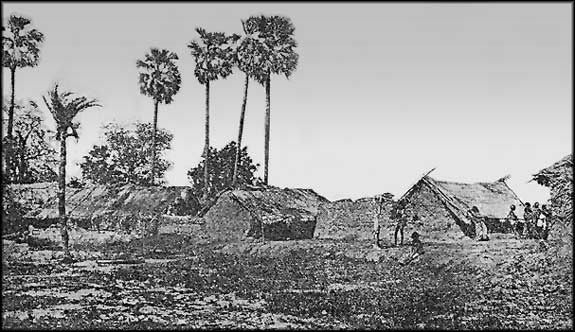 The Village of Bodh Gaya in 1900.
The Village of Bodh Gaya in 1900.The name Bodh Gaya has been spelt variously as Boodha Gaya, Buddh Gya, Bauddha Gyah, Bodhi Gaya, and Buddha Gaya. In any of its forms, it is not an old name, first occurring in the spurious inscription of Amaradeva, a document of uncertain but recent date. At the time of the Buddha, the village was named Uruvela. According to 5th century commentator Dharmapala, it was given this name because of the large amount of sand (vela) in the area. He tells a delightful story to explain the presence of all this sand. In the distant past, long before the Buddha, a company of ascetics lived in the area. They could tell which one of their fellows committed an unwholesome bodily or verbal act, but not if they had an unwholesome thought. So they came to an agreement among themselves, that whoever thinks an unwholesome thought should bring sand in a leaf basket. Soon the whole area was covered with sand.
Other sources say the village was given the name on account of a vilva tree (Aegie marmelas) growing nearby. It seems that within two centuries of the Buddha's enlightenment, the name Uruvela fell into disuse and was replaced by four other names: Sambodhi, Bodhimanda, Vajrasana and Mahabodhi. The oldest and least commonly used of these names was Sambodhi, meaning 'complete enlightenment'. In his Eighth Rock Edict issued in 256 BC, King Asoka says he "went to Sambodhi" (ayaya Sambodhi) referring to his pilgrimage to Bodh Gaya four years previously. Another ancient name, Bodhimanda, refers to a circular area around the Bodhi Tree. The Kalingabodhi Jataka describes the Bodhimanda before the Buddha's enlightenment as being covered with silvery sand without a blade of grass growing on it and with all the surrounding trees and flowering shrubs bending, as if in homage, towards the Bodhi Tree.
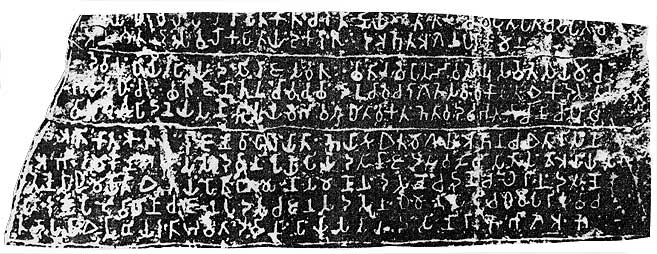 Rock Edict VIII Girnar
Rock Edict VIII GirnarThe exact place where the Buddha sat when he was enlightened was called Vajrasana meaning 'Diamond Throne'. It was believed that when the universe is finally destroyed, this would be the last place to disappear and that it would be the first place to form when the universe began to re-evolve again. The Vajrasana was also sometimes called The Victory Throne of all Buddhas (Sabbabuddhanam Jayapallankam) or the Navel of the Earth (Pathavinabhi). In later centuries the name Vajrasana came to be used for the exact location of the Buddha's enlightenment, for the temple built over it (Vajrasana Gandhakuti) and for the general location.
The most widely used and also the most enduring of Bodh Gaya's names was Mahabodhi meaning 'great enlightenment'. Originally a term for the Buddha's experience, it later came to be used as the name for the place where that experience had occurred. Cunningham mentioned that this name was still in vogue in the 19th century. The Buddha's experience at Uruvela not only resulted in the location changing its name to Bodh Gaya; it has also meant that this otherwise obscure village has been the focus of attention for millions of pilgrims for over two millennia. It became very early, and remains even today, the most important place of Buddhist pilgrimage. Those who see Buddhism as an entirely rational religion will insist that it has no place for practices like pilgrimage. However, this view is somewhat at odds with what the Buddha himself said. Just before his final Nirvana, he encouraged all his disciples to visit at least once the places where the pivotal events in his life occurred: Lumbini, Bodh Gaya, Isipatana and Kusinara:
"Ananda, there are four places the sight of which will arouse strong emotion in those with faith. Which four? 'Here the Tathagata was born', this is the first place. 'Here the Tathagata attained Enlightenment', this is the second place. 'Here the Tathagata set in motion the Wheel of the Dhamma', this is the third place. 'Here the Tathagata attained final Nirvana without remainder', this is the fourth place. The monk or nun, layman or laywoman, who has faith should visit these places. And anyone who dies while making a pilgrimage to these places with a devout heart will, at the breaking up of the body, be reborn in heaven".While it is true that the Buddha had high regard for reason, he did at the same time recognise the importance of emotion in all human endeavours, including the quest for enlightenment. For the devout person, seeing the Buddha or even thinking about him can evoke a joy which, when controlled and purified, can be transformational. Going to a place made sacred by the Buddha's presence, or even the process of getting there, can have a similar effect. On the open road, away from mundane preoccupations and familiar surroundings, the pilgrim has time to think about his or her life and practice of the Dhamma. The arduous but steady progress towards the goal may become analogous to the pilgrim's journey on the Eightfold Path and stimulate the determination to walk that Path with more commitment. On finally reaching the goal, the pilgrim will see places and sights associated with the Buddha which can arouse intense faith and provide the opportunity for deep contemplation.
In ancient times, there were several approaches to Bodh Gaya. Pilgrims coming from the west could go overland from Benares, taking the same road that the Buddha took in the first year after his enlightenment. The other way was to sail further down the Ganges to Pataliputra and then take the road south to Gaya, or alternatively, the slightly longer road that passed through Nalanda, Rajagaha and Kurkihar. Pilgrims from Bengal or Orissa would sail up the Ganges or take the road that linked Magadha to Tamralipti. These approaches were an integral part of the great road system that connected the towns and cities of the Ganges valley.
There were three main routes in this system - the northern which paralleled the Himalayan foothills and connected Ahicchatra, Sravasti and Saketa to Benares; the central which followed the Ganges and passed through Hastinapura, Sankasya and Kanyakubja to Prayaga; and the southern which followed the Yamuna, passed Kausambi and joined the central route at Prayaga. A branch of the northern route went from Sravasti, through Kapilavatthu, Kusinara and Vesali to Pataliputra. Pilgrims from Kashmir, Bactria and beyond followed the great trunk road that started at Taksila and ran to Hastinapura where it joined the northern route. Few records of pilgrims from these regions have survived.
A monk named Viradeva from Bactria is known to have visited Bodh Gaya twice, once as a young man, and again many years later when he was appointed head of the great monastery at Nalanda. I Tsing mentions a monk from Samarkand who came to Bodh Gaya, where he burned lamps for seven days and set up statues of the Buddha and Avalokitesvara at the foot of the Bodhi Tree. Sindh was a predominantly Buddhist region until the Arab invasion in the 8th century. The earliest record of pilgrims from this region coming to Bodh Gaya is an inscription thought to date from the reign of King Gopala II (950 -970).
From Sindh there were three ways to the Ganges valley, one starting at Roruka and another at Sibipura, which both converged at Sairisaka from where it ran to Indraprastha and Mathura. Another possibility was to go from Patala to Gujarat, and then take the main road to the north through Ujjayini and Vidisa. The southern end of this road passed Nasikya and Ajanta, and was the main route for pilgrims coming from Deccan and the cities on the northwestern seaboard. Pilgrims from the Tamil country and Andhra could go either by foot or ship up the east coast to Tamralipti. No evidence of visits by South Indian Buddhists have yet been found at Bodh Gaya, but pilgrims from Kerala and particularly from Kanchipuram are known to have visited Kurkihar in large numbers during the 10th and 11th centuries. It is inconceivable that they did not go the extra 16 miles to Bodh Gaya.
Pilgrims from beyond India travelled on the international trade routes. Sri Lankans embarked from either Mahatittha or Jambukola and sailed up the coast to Tamralipti, sometimes stopping at Kanchipuram or Amaravati on the way. Going directly with a favourable breeze, the pilgrim could be in Tamralipti in as little as 14 days. The Rasavahini's mention of a four month journey from 'the further shore' (i.e. the Indian coast opposite Sri Lanka) to Bodh Gaya must have applied to those who made the whole journey on foot. Pilgrims from Sumatra and Java usually arrived at Tamralipti via South Indian ports, taking advantage of the large number of ships that sailed between the two regions.
During the 11th century, Acarya Dharmakirti of Sumatra, probably the greatest Buddhist scholar Southeast Asia ever produced, made a pilgrimage to Bodh Gaya, Lumbini and Kapilavatthu, although it is not known what route he took to India. Ships from Burma avoided the open sea because of the sudden storms in the Bay of Bengal, but as a consequence were often a prey to the notorious Malay pirates that infested the Araccan coast. Amongst the numerous graffiti that pilgrims scratched on the rocks at Uren, the probable abode of Avalaka, are some in Burmese script. Pilgrims from Burma sailing up the Ganges to Bodh Gaya via Pataliputra must have broken their journey there to visit Uren's shrines. It was also possible for Burmese to go overland through Assam, but few seemed to use this particularly dangerous route.
According to the famous Kalyani inscription, a 13th century Burmese monk took advantage of the psychic powers he had developed in meditation to fly to Bodh Gaya each day and sweep the temple courtyard. While this story may not be true, it does reflect the intense desire that many Burmese had to visit the site of the Buddha's enlightenment. Chinese and Korean pilgrims had two choices, to go by ship through Southeast Asia or overland through the mountains and deserts of Central Asia. This second route in particular posed numerous difficulties, some of which the monk Sung Yun described:
"Along the road, the cold was very severe while the winds, driving snow and the pelting sand and grit were so bad that it was impossible to raise one's eyes without getting them filled".A few Chinese pilgrims went by a third route, through Tibet and Nepal, a journey that was still a formidable undertaking well into the 20th century. The Korean monk Yuan Tai went this way to Bodh Gaya. On his return journey through Central Asia, he met another monk going to Bodh Gaya and decided to accompany him. After this second visit, he managed to return safely to his homeland. The only Japanese known to have attempted a pilgrimage to India in ancient times was Prince Takaoka, who had been an heir to the throne before becoming a monk. In 866 AD, at the age of 70, he set sail from Canton but was never heard of again. He is thought to have died somewhere in the Malay Peninsula before having reached his goal.
Vietnamese began going to India on pilgrimage soon after the introduction of Buddhism into their country in the 6th century. One of the earliest such records concerns two monks, Khuy-Sung Phap Su and Minh Vien, who took a ship to Sri Lanka, sailed up the west coast of India and then went from there by foot to the holy land. The two companions reached Bodh Gaya and then continued on to Rajagaha where poor Khuy-Sung died. He was only twenty five years old. According to Shes-bya-kun-khyab the first Tibetan to go to Bodh Gaya was Akaramatisila who was sent to India by Srong-btsan-sgam-po to get a statue of Avalokitesvara. On the way back he stopped in Bodh Gaya to get leaves from the Bodhi tree and sand from the Naranjara River. The earliest evidence of pilgrims from Nepal coming to Bodh Gaya is a number of coins dating from the reign of the Nepalese King Pasupati (approximately 400 AD).
 Coin of King Pasupati
Coin of King PasupatiMost pilgrims travelled on foot or by bullock cart, except where it was possible to ply the Ganges or the Yamuna. Monks slung their bowl and water pot over their shoulder and carried either an umbrella or staff. The Vinaya says that a staff should be four times the length from the fingertips to the elbow of a man of average height. In later times, the staff, called a khakharaka because of the jingling sound made by the metal rings on its top, became a symbol of wayfaring and pilgrimage, much as the bourdon did in medieval Christendom. The pilgrim could use it to ward off unfriendly dogs or wild animals, and give notice of his presence when he went begging for alms. Ksitigarbha, the bodhisattva who protects travellers, is always depicted holding such a staff.
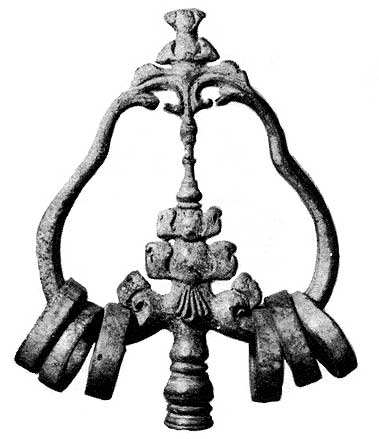 Chinese and Japanese mendicant monks carried the iron-ringed staff of the Bodhisattva Kshitigarbha.
Chinese and Japanese mendicant monks carried the iron-ringed staff of the Bodhisattva Kshitigarbha.Senior monks from more wealthy monasteries travelled by palanquin, accompanied by an attendant with their belongings. The travelling kit of Sri Lankan monks on pilgrimage within their own country would consist of a water strainer, needle and thread, a small jar of oil for massaging the feet, nail clipper, tinder and flint, and a pair of sandals with a case to put them in. Those who went to India must have been similarly outfitted. Local guilds, philanthropists and kings sometimes built simple rest-houses along main roads which offered shelter, although little more, for pilgrims and traders.
The Manjusrimulakalpa eulogised the 8th century King Gopala as "a maker of beautiful rest-houses and bridges". There were no inns in ancient India; centres of pilgrimages had dharmasalas, but beyond that, travellers arriving at a town and needing accommodation had to go from door to door looking for someone who might take them in. It was a little easier for monks. Wayside temples would take in travelling monks for three, or in some places five, days, after which they would have to move on. But temples were not always hospitable, particularly if the monk seeking accommodation was from a rival sect or a foreign country.
Hsuan Tsang visited a monastery cast of Benares named Aviddhakarna Vihara (Monastery of the Unpierced Ears) and was told an interesting story of why it was built and how it got its name. A group of monks from beyond India's northwestern frontier were on pilgrimage but could find no monastery that would take them in. One day, the king happened to see them in the street and, recognising that they were not Indians by the fact that their ears were unpierced, asked them why they were so ragged and thin. When they told him, he decided to build a monastery for the exclusive use of foreign monks. Indians, that is those with pierced ears, were not allowed to stay there and hence the monastery's name.
There are known to have been several other monasteries for foreign monks travelling or studying in India, one at Bodh Gaya for Sri Lankans, one at Nalanda for Javanese and Sumatrans, and another east of Nalanda for Chinese. This 'Cheena Vihara' had been built by King Sri Gupta and allotted 24 villages for its upkeep. But even when monasteries were unavailable, lay people were usually happy to help travelling monks. In the Sihalavatthupakarana there is a story of seven Sri Lankan monks who arrived at Pataliputra on their way to Bodh Gaya. The daughter of a rich merchant saw them in the street and invited them into her home for a meal. On being told they were on their way to Bodh Gaya, she gave them golden flowers, incense and lamps to offer at the Bodhi Tree on her behalf. She also provided them with servants and a bullock cart for the final stage of their journey.
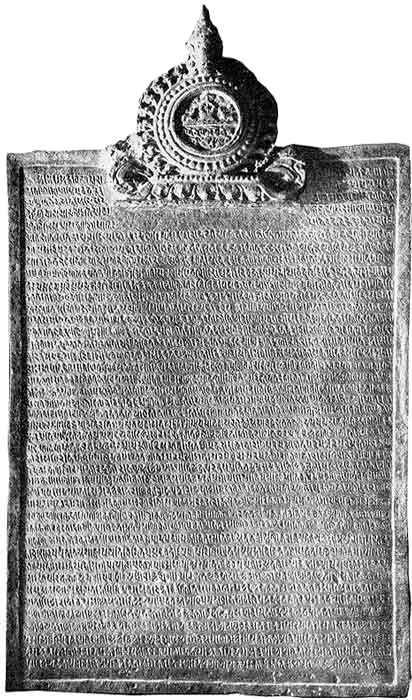 Inscription from the Indonesian monastery at Nalada
Inscription from the Indonesian monastery at NaladaFor safety's sake, pilgrims usually travelled in groups or teamed up with caravans that plied the main trade routes. The monk Nagasena travelled from northwest India to Pataliputra with a caravan of 500 wagons. The caravan leader supplied all his food and, when they finally parted, gave him a beautiful woolen blanket. In about the middle of the 11th century, the envoy sent to invite Atisa to Tibet travelled to Bodh Gaya with the king of Nepal and his entourage before completing his mission. Another Tibetan, Dharmasvamin, and 16 other pilgrims on their way to Bodh Gaya in 1234, travelled through northern Bihar with a party of 300 Nepalese Hindus taking their deceased parents' ashes to immerse in the Ganges.
When Hiuen Tsiang was in Kanchipuram in the 7th century some 300 Sri Lankan monks arrived in the city. It seems they had found it judicious to come to India on pilgrimage at that particular time due to political upheavals in the island following the death of the king. Later Hiuen Tsiang travelled through the Tamil country with 70 of these monks; apparently they were going to north India. To help pay their way, many pilgrims would buy goods in one destination to sell them in another. Visaka of Pataliputra sewed coins into the hem of his garment before setting out on his journey. He used the month he was kept waiting for a ship to do some business and managed to make a handsome profit.
A Tibetan monk earned 12 gold zos, enough money to finance his pilgrimage to India, by copying out two sets of the Satasahasrikaprajnaparamita Sutra. Some incurred expenses even before they set out. Hindus from Kashmir going to Gaya had to pay a special pilgrim's tax, and we can assume it must have been the same for Kashmiri Buddhists going to Bodh Gaya. For Chinese pilgrims it was not taxes but the formidable imperial bureaucracy that posed the greatest obstacle. Before leaving the country they had to apply for and obtain a passport.
The popularity of pilgrimage gave rise to a whole body of literature, mainly sutras praising the holy places and exhorting the faithful to visit them. Sri Lankan monks had small handbooks (muttipotthaka) listing the Buddha's virtues which they could read while they travelled. There were also guide books (mahatyaya) to help pilgrims to find their way, and inform them of the times of particular festivals that were held at each sacred place. Some of the early biographies of the Buddha, like the Lalitavistara, are thought to have been based upon such guide books which in turn grew out of the patter that guides at the various holy places used. Although no guide books have survived, several such works are known. The only one of these about which we have any details is the guidebook to Bodh Gaya written by Jamdun Rigpel Rilti in the 14th century.
Ancient Buddhist maps always showed either Mount Meru or Bodh Gaya in their centre. The most famous of these is the Gotenjiku Zu, Map of the Five Indias, drawn by the Japanese monk Juaki in 1364. This map is based carefully on Hiuan Tsiang's account of his pilgrimage to India and indeed even marks his route with a red line. Mount Meru and Lake Anotatta with the traditional four rivers flowing out of it is shown in the centre while Bodh Gaya is located towards the southeast. The purpose of maps like the Gotenjiku Zu was didactic and scholarly rather than practical. This is clear from Juaki's own words. He says; "With prayers in my heart that Buddhism might prosper, I engaged myself in the task of making this copy, wiping my eyes which are dim with age, and feeling that I myself were actually travelling through India". However route maps meant to be used by those going to India did exist too. These were probably not available for ordinary pilgrims but were made by and for royal embassies visiting India. One of the few such maps that survives, from northern Thailand, was drawn in the 19th century although based on a much earlier prototype, probably by someone who had actually been to India. The map shows important pilgrimage sites like Rajagaha, Kusinara, Campa and Dona's stupa, and gives their direction and the number of days needed to reach them from the Mahabodhi Temple, which is depicted in the centre of the map.
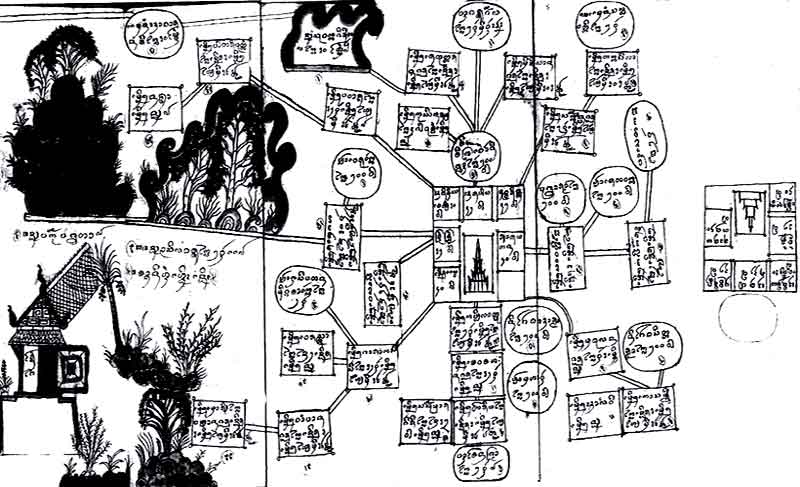 Portion of a Lanna Thai map believed to relate to places of pilgramage visited by a long-resident Thai pilgrim in India.
Portion of a Lanna Thai map believed to relate to places of pilgramage visited by a long-resident Thai pilgrim in India.In order to facilitate both trade and pilgrimage, King Asoka had main roads lined with trees, and wells dug at regular intervals along them. He also had the road from Bodh Gaya to his capital at Pataliputra straightened and repaired. However, throughout most of India's history, roads were appallingly bad and travel for any reason was difficult and dangerous. The remains of two finely built roads that ascend the hill at Sanchi show the capabilities of ancient Indian engineers. But these roads were probably only for royal processions; pilgrims had to scramble up the hill as best they could. At Chikni Ghati on the northeastern side of the hill, the feet of generations of pilgrims have worn the rocks smooth. Bridges were rare, and rivers usually had to be forded or crossed by ferry. According to the Lalitavistara, a ferryman refused to take the Buddha across a river because he had no money to pay the fee, a story that must have mirrored the experience of many a wayfaring monk and poor pilgrim.
A 13th century Tibetan pilgrim mentions crossing the Ganges on a craft that consisted of two square rafts lashed together. The river was full of crocodiles that would sometimes try to upset craft or snatch passengers off their decks. In some areas the distances between one town and the next were considerable, and pilgrims were in danger of getting lost or running out of provisions. In the Anguttara Nikaya we read of the traveller's relief on coming upon a pond where he could drink (and perhaps swim, eat some lotus roots and rest in the shade) before moving on refreshed. Others might have to get down on all fours and drink from a wayside puddle because no other water was available. Less lucky pilgrims perished from hunger and thirst. Sickness was always a threat, especially for those not used to India's dust, heat, and poor food and water.
The Korean pilgrim Hsuan-Ko made it all the way to Bodh Gaya only to die of sickness a few days after his arrival. One of Fa Hien's companions died of altitude sickness while crossing the Hindu Kush. But the the perennial problem of travel in India was banditry. Nearly every traveller in the subcontinent up to the last century mentions this danger. The boat that Hsuan Tsang took down river to Prayaga was attacked by river pirates who dragged it to the shore, robbed the passengers, and then decided that the Chinese pilgrim with his fair skin would be a suitable sacrifice for their goddess Kali. It was only by a stroke of luck that he escaped with his life.
After returning from Tibet in 1426, the Indian Tantric adept Vanaratna planned to go to Bodh Gaya to pay his respects and erect a statue of his teacher. But upon learning that bandits were laying in wait to steal the Tibetan king's gifts that he was carrying, he had to cancel his trip. Some poor pilgrims had to endure all these difficulties and more. In the account of his third journey to India, during which he went to Bodh Gaya, a peeved Marpa complained that he encountered bandits, wild animals and suffered greatly from fever and the searing heat of the Indian plains.
The vicissitudes faced by the Chinese pilgrim I Tsing, during his journey to Bodh Gaya in the 7th century, were perhaps typical of many. Before leaving China, I Tsing met with the captain of the Persian ship he was travelling on, visited his teacher's grave and said farewell to his family and friends. Embarking at Canton in 671 AD, the ship took 20 days to reach Bogha (probably Jambhi in Sumatra) where he stayed for 2 months learning Sanskrit in preparation for his arrival in India. After a further 2 months' stay in Kedha, he set sail again. Ten days out, the ship stopped at the Andaman Islands, where water and provisions were exchanged with the natives for iron. Another half a month sailing across the Andaman Sea and I Tsing's ship finally arrived at Tamralipti. There, to his delight and surprise, he met a monk from his homeland. After a few more months' study at one of Tamralipti's monasteries, the two men joined up with a party of several hundred merchants and monks heading for Magadha. Ten days journey from Bodh Gaya, the party passed through a wilderness and I Tsing, being sick, fell behind. Around sunset, a group of men approached the lone pilgrim and began insulting him and threatening him with their weapons. Finding that he had nothing of value to steal, they stripped him of his clothes, obliging him to cover himself with a handful of leaves. Staggering on through the darkness, he finally arrived at the next village where he was able to rejoin his companions. Twenty monks in the party were going directly to Nalanda and, not wishing to travel alone, I Tsing decided to accompany them and proceed to Bodh Gaya from there. On finally arriving at his goal, he offered the silk and canopies that had been given to him for the purpose by friends in China to the Mahabodhi image, and prayed for the peace and prosperity of his homeland.
Later I Tsing visited all the other sacred places and then spent 10 years studying at Nalanda, before finally returning to China in 695 AD. Despite these and other difficulties, pilgrimage remained an important and popular religious practice for centuries. During Buddhism's heyday in India, millions of people from both within the subcontinent and beyond its borders travelled to Bodh Gaya and other sacred places. This great movement of people had a significant impact on Indian culture. Going to any place of Buddhist pilgrimage required passing at least several others, which helped widely separated monastic communities to keep in contact with each other. It also facilitated the spread of new ideas while allowing Indian Buddhism to retain a unified character. Foreign pilgrims brought news of the conditions of Buddhism in far off places and stimulated Indian monks to travel abroad. They also carried back to their homelands relics, books, statues and even plans of Indian temples, all of which had an impact on the art and thought in other parts of Asia.
Foreign pilgrims occasionally kept in contact with Indians they had met during their travels, sometimes for many years. The most remarkable example of such long-distance relationships are the letters that passed between the Chinese monk Hsuan Tsang and two monks from Bodh Gaya, Prajnadeva and Jnanaprabha. Seven years after his return to China in 641, Hsuan Tsang received letters and several rolls of cotton cloth from these monks. In their letters, they wished Hsuan Tsang well, passed on the regards of a mutual friend and offered to send him any books he might need for his studies. Two years later, when a Chinese monk was setting out for India, Hsuan Tsang gave him two letters to be delivered at Bodh Gaya. In his reply to Prajnadeva, Hsuan Tsang expressed his delight in hearing from his friend after so long, talked about the weather and his work, and also gave a list of books he wanted sent. The fact that letters, gifts and books could be passed from one individual to another over such vast distances indicates that pilgrim traffic to and from Bodh Gaya must have been very considerable.
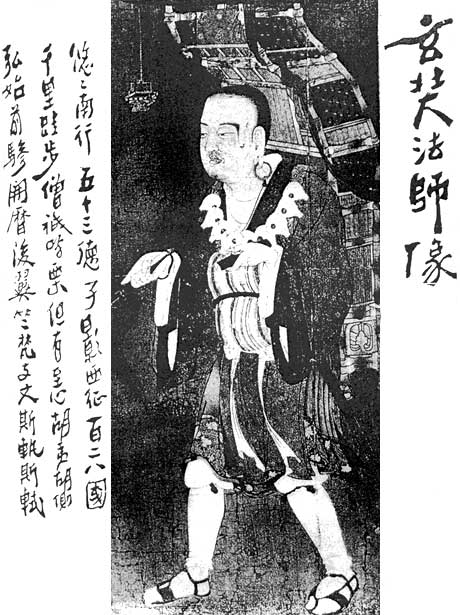 Hsuan Tsang, 603-664 A.D.
Hsuan Tsang, 603-664 A.D.The dangers and expense involved in going to India on pilgrimage meant that only a very small number of devotees were able to do it. Most had to be content with visiting the centres of pilgrimage that grew up in their own lands, and this trend was extenuated after the Muslim conquest of India. This diversion of people away from Bodh Gaya was a factor in its gradual decline, and also in its inability to recover from the blows inflicted on it in the 13th century. However, although the stream of Buddhists to Bodh Gaya declined dramatically, it never stopped completely. A trickle of pilgrims, mainly from Tibet, Nepal and Burma, continued right up to the 19th century. But it was not until the Mahabodhi Society started organising pilgrimages in the 1890's that significant numbers of people began coming again. Going to Bodh Gaya is once more a part of Buddhist practice and perhaps more pilgrims make the journey today than ever before in history
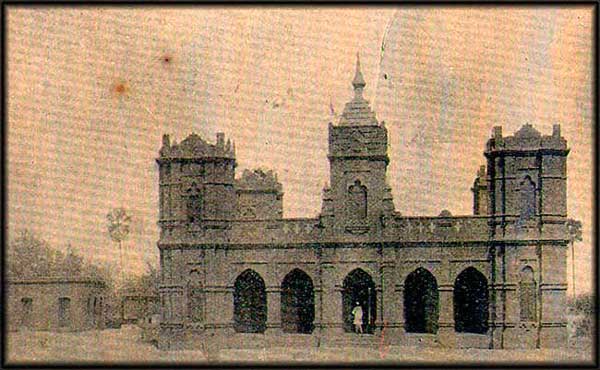 The Mahabodhi Preaching Hall at Bodh Gaya in the 1890's.
The Mahabodhi Preaching Hall at Bodh Gaya in the 1890's.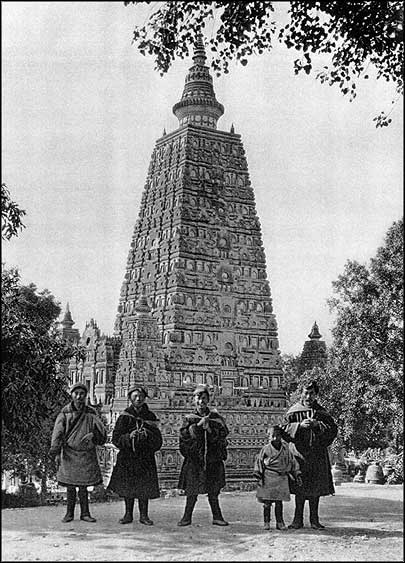 Tibetan Pilgrims at the Mahabodhi Temple, 1948.
Tibetan Pilgrims at the Mahabodhi Temple, 1948.